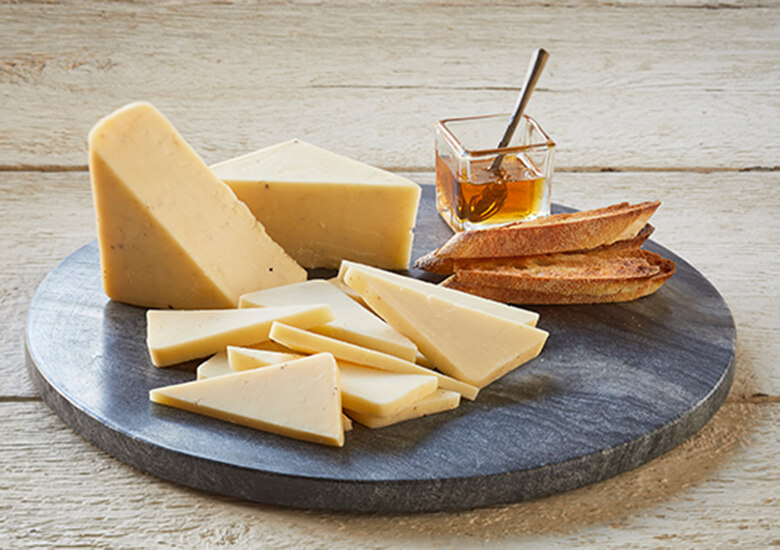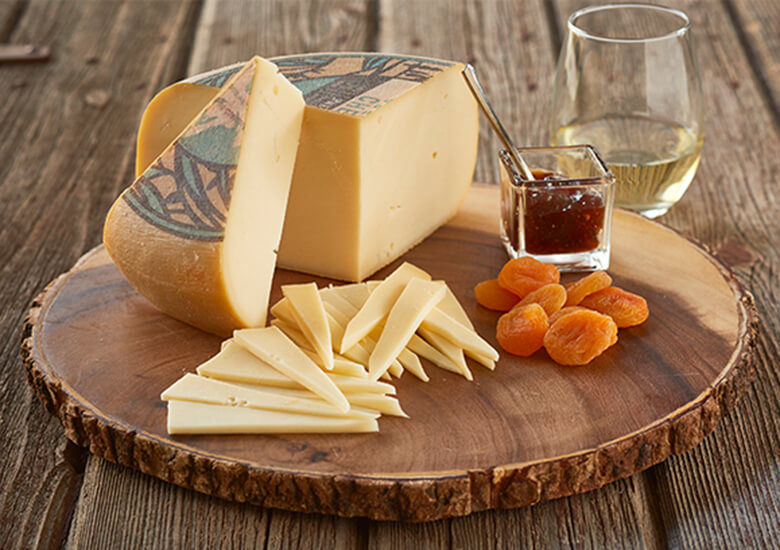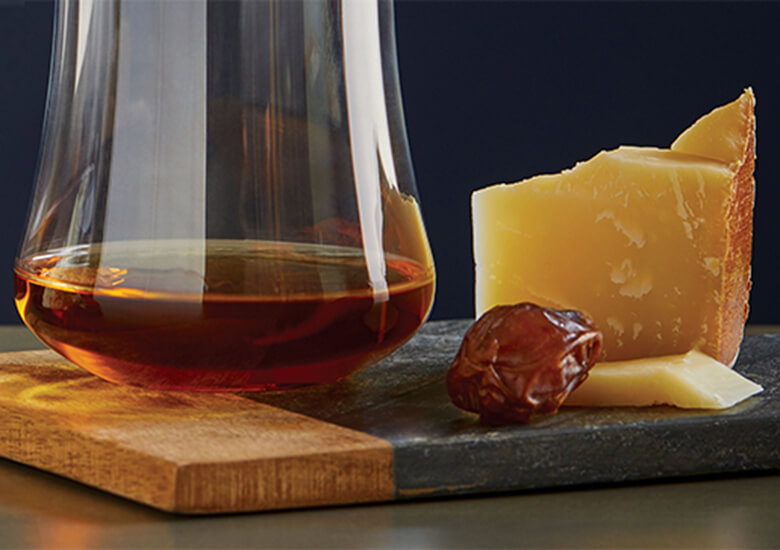Every cheese has a story to tell, and for alpine-style cheese that means a journey spanning from the dramatic, sun-kissed mountains of the Alps to the rolling green hills of Wisconsin’s countryside.
For Wisconsinites, alpine-style is more than just a cheese—it’s a way to connect with Old World traditions while embracing the future. The best part is just how many varieties of alpine-style cheeses there are, each special in its own way. Read on for a few of our favorite things.
Cheese History: The story behind alpine-style cheese

What exactly is alpine-style cheese? In the simplest terms possible, alpine-style cheese refers to a broad umbrella of cheeses like gruyère, emmental, and swiss that were first created in Europe’s mountainous region known as the Alps.
Cheese historians trace the history of alpine-style cheeses to the fourth century when the Swiss were moving cows to summer in mountain meadows for grazing in order to make room in the valleys for other forms of agriculture. Master cowmen spent summers managing cows, milking, and making cheese. This combination of practices - summer mountain grazing and cheesemaking - proved so successful that it spread across Europe with each region developing its own tricks of the cheese trade. By the end of the Middle Ages, big wheels of long-aged, semi-hard, nutty-flavored cheeses, a.k.a. alpine-style cheeses, existed as we know them today.
Here in Wisconsin, cheesemakers have taken up the mantle of continuing the tradition of alpine-style, pushing the boundaries by mixing Old World techniques with modern-day innovation and creativity.
Award-winning alpine-style cheeses like Roth’s Grand Cru®, Grand Cru Reserve, and Grand Cru Surchoix are inspired by the same cheesemaking techniques that they used in centuries past but mixed with some Wisconsin flare.
All about alpine-style cheese

Are there different types of alpine-style cheese?
Alpine-style cheese encompasses a huge variety of different cheeses —all originally born in the Alps before making their way over to Wisconsin. When most of us think of the Alps, we picture beautiful valleys and farmland surrounded by towering mountains in Switzerland. While this isn’t wrong, it’s an incomplete image. In fact, the Alps run through portions of France, Italy, Germany, Slovenia, and Austria. Suffice it to say, there’s plenty of Alpine inspiration to go around!
Here are a few of the most well-known alpine-style cheeses:
Swiss: Few could confuse this hole-y cheese for anything other than what it is: swiss. It’s buttery, nutty, and finishes with some slight sweetness. In Wisconsin, swiss cheese has quickly become a favorite of cheesemakers and eaters alike—and what’s not to like? Whether you’re enjoying it in a deli sandwich like a Reuben or snacking on a slice solo, swiss is always the right choice.
Emmental: This gloriously melty cheese is a specific type of Swiss cheese hailing from the idyllic town of Emmentaler in Switzerland. Just like how not all sparkling wines can be called Champagne, not all swiss cheeses can be called emmental (or emmenthaler, as some call it). Emmental is mild, buttery, and some even say fruity! We’re grateful that Wisconsin’s Master Cheesemakers built upon Emmentaler’s legacy to make a cheese we’d welcome to any fondue party.
Gruyère: One of Switzerland’s most famous alpine-style creations, gruyère makes its mark with nuance and complexity. When you savor gruyère cheese, you'll find fruity tones, nutty notes, and earthy flavors. In Wisconsin, we often call it alpine-style and enjoy its creamy, smooth goodness on everything from French onion soup to mac and cheese to fondue.
Butterkäse: German for “buttery cheese,” this cheese is decadent, creamy, and perfectly mild. Basically, butterkäse is the ideal cheese to have alongside a refreshing weiss beer during an Oktoberfest-themed celebration.
Fontina: If you’ve never tried Wisconsin-made fontina, you’re in for a treat. This alpine-style cheese originates from the Italian side of the Alps where it was made for centuries before some pioneering cheesemakers emigrated to Wisconsin at the turn of the 19th century. Wisconsin fontina is mild and nutty like many other alpine-style cheeses, but with a touch of savory earthiness, a.k.a. Wisconsin terroir, that distinguishes it from the rest of the family.
Comté: Born in the Franche-Comté region of eastern France, comté is a close sibling of gruyère. Both gruyère and comté follow nearly identical recipes and aging processes, but can be differentiated by the uniqueness of their regional terroir. As any cheese lover worth their fondue pots will tell you, factors as small as the grass that cows graze on can impact the flavor of a cheese. Try them side-by-side and see if you can smell and taste the difference.
Beaufort: We don’t like picking favorites when it comes to alpine-style cheeses—they’re all unbelievably good, but beaufort-style cheese is particularly special. Compared to gruyère or comet, beaufort cheese tastes lighter and a bit more floral; a result of the summer milk used to make it. Beaufort cheese is actually what inspired Uplands Cheese to make Pleasant Ridge Reserve, the most awarded cheese in U.S. history.
What does alpine-style cheese taste like?

No two alpine-style cheeses will taste alike, but there are some common traits that many of them share. For starters, most alpine-style cheeses are on the mild end of the spectrum compared to more piquant cheeses like limburger or gorgonzola.
There are exceptions of course. For example, some cheesemakers choose to age their alpine-style cheeses longer to concentrate the intensity of the flavor. Alpine-style cheeses are also famous for having just the right balance of savory and sweet, making them ideal pairing cheeses for a variety of light beers, fruity wines, and sweet spirits.
What does alpine-style cheese look like?
Alpine-style cheese comes in countless shapes, sizes, and textures. From off-white ivory to a beautiful pale gold, the colors of alpine-style are vibrant and bright like the final rays of light before a dusky sunset.
Did we mention the famous holes? Many alpine-style cheeses like swiss and emmental are famous for their many “eyes.” These curious creations are a result of the cheesemaking process where a starter culture containing the bacterium Propionibacter shermani eats up lactic acid and produces pockets of carbon dioxide that get trapped in the cheese. These pockets of gas are what give many alpine-style cheese their characteristic holes.
Pairing alpine-style cheeses

Alpine-style cheeses are a breeze to pair thanks to their laid back, slightly sweet taste. Anything from a light pilsner to a rich cognac will be right at home with a slice of alpine-style cheese. If you’re ready to take a deeper look into the world of cheese pairing, we recommend starting with our beginner’s guide to cheese pairing.
What beer goes well with alpine-style cheese?
Alpine-style cheeses generally pair well with light to moderately alcoholic beer, particularly ones that have a hint of sweetness. Here are some of our favorite beer pairings:
Butterkäse and weiss beer
Swiss and pilsner
Emmental and Belgian stout
Fontina and saisons
What wine pairs best with alpine-style cheese?
When pairing alpine-style cheese with wine, we lean toward fruit-forward whites and reds that are easy on the tannin. Too much tannin can leave an astringent, bitter sensation in your mouth that just doesn’t play well with most semi-sweet alpine-style cheeses.
Butterkäse and chardonnay
Swiss and pinot noir
Emmental and riesling
Fontina and Chianti
What spirits should I have with alpine-style cheese?
Dessert spirits and digestifs make great partners for alpine-style cheeses. We’d never get in the way of a bourbon or scotch pairing either—just be mindful that the oaky or smoky flavors don’t overwhelm the more delicate notes in an alpine-style cheese. Like we covered in our brown liquor and cheese pairing guide, it’s all about matching intensities!
Butterkäse and port
Swiss and brandy
Emmental and Cognac
Fontina and light scotch (avoid the peaty stuff)
Time to try some alpine-style cheese!
If all this talk of cheese has gotten you hungry for a cheese tasting, you can get Wisconsin’s finest alpine-style cheeses delivered right to your door with our continuously updated list of cheesemakers and retailers that allow you to order cheese online. Award-winning Wisconsin Cheese is just a click away.
Craving something else? Choose from our selection of over 400 recipes featuring Wisconsin Cheese. Don’t forget to share your creative cheesy creations with us on Facebook and Instagram!
FAQs
What is gruyère cheese similar to? Gruyère is quite similar to other alpine-style cheeses like emmental or fontina. Some also consider swiss to have a comparable flavor, although most find it to be milder.
Is fontina a hard cheese?
Fontina is a semi-firm to firm cheese that sometimes has very small holes (or “eyes” as cheesemakers call them).
Why does swiss cheese have holes?
Get ready for some cheese science! Near the beginning of the cheesemaking process, a bacterial culture is added to the milk. The bacteria responsible for the holes is called Propionibacter shermani. This bacterium eats up lactic acid produced during the cheesemaking process and releases pockets of carbon dioxide gas. These pockets of gas are what’s responsible for the holes.
What is emmental cheese used for?
Emmental is most famous for its use in fondue, where it accompanies swiss to create the classic, melty cheese dip that’s famous across the world. Emmental is a delightfully melty cheese that makes a great topping for potatoes, hash browns, or just sliced on a sandwich.

If you liked this article, check out these related ones
